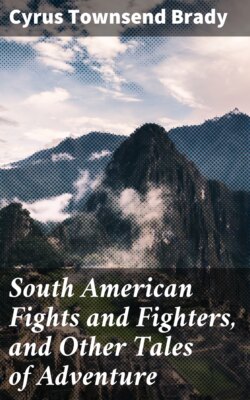Читать книгу South American Fights and Fighters, and Other Tales of Adventure - Cyrus Townsend Brady - Страница 17
На сайте Литреса книга снята с продажи.
I. The Coming of the Devastator
ОглавлениеTable of Contents
This is the romantic history of Vasco Nuñez de Balboa, the most knightly and gentle of the Spanish discoverers, and one who would fain have been true to the humble Indian girl who had won his heart, even though his life and liberty were at stake. It is almost the only love story in early Spanish-American history, and the account of it, veracious though it is, reads like a novel or a play.
After Diego de Nicuesa had sailed away from Antigua on that enforced voyage from which he never returned, Vasco Nuñez de Balboa was supreme on the Isthmus. Encisco, however, remained to make trouble. In order to secure internal peace before prosecuting some further expeditions, Balboa determined to send him back to Spain, as the easiest way of getting rid of his importunities and complaints.
A more truculent commander would have no difficulty in inventing a pretext for taking off his head. A more prudent captain would have realized that Encisco with his trained mouth could do very much more harm to him in Spain than he could in Darien. Balboa thought to nullify that possibility, however, by sending Valdivia, with a present, to Hispaniola, and Zamudio with the Bachelor to Spain to lay the state of affairs before the King. Encisco was a much better advocate than Balboa's friend Zamudio, and the King of Spain credited the one and disbelieved the other. He determined to appoint a new governor for the Isthmus, and decided that Balboa should be proceeded against rigorously for nearly all the crimes in the decalogue, the most serious accusation being that to him was due the death of poor Nicuesa. For by this time everybody was sure that the poor little meat-carver was no more.
An enterprise against the French which had been declared off filled Spain with needy cavaliers who had started out for an adventure and were greatly desirous of having one. Encisco and Zamudio had both enflamed the minds of the Spanish people with fabulous stories of the riches of Darien. It was curiously believed that gold was so plentiful that it could be fished up in nets from the rivers. Such a piscatorial prospect was enough to unlock the coffers of a prince as selfish as Ferdinand. He was willing to risk fifty thousand ducats in the adventure, which was to be conducted on a grand scale. No such expedition to America had ever been prepared before as that destined for Darien.
Among the many claimants for its command, he picked out an old cavalier named Pedro Arias de Avila, called by the Spaniards Pedrarias.[1]
This Pedrarias was seventy-two years old. He was of good birth and rich, and was the father of a large and interesting family, which he prudently left behind him in Spain. His wife, however, insisted on going with him to the New World. Whether or not this was a proof of wifely devotion—and if it was, it is the only thing in history to his credit—or of an unwillingness to trust Pedrarias out of her sight, which is more likely, is not known. At any rate, she went along.
Pedrarias, up to the time of his departure from Spain, had enjoyed two nick-names, El Galan and El Justador. He had been a bold and dashing cavalier in his youth, a famous tilter in tournaments in his middle age, and a hard-fighting soldier all his life. His patron was Bishop Fonseca. Whatever qualities he might possess for the important work about to be devolved upon him would be developed later.
His expedition included from fifteen hundred to two thousand souls, and there were at least as many more who wanted to go and could not for lack of accommodations. The number of ships varies in different accounts from nineteen to twenty-five. The appointments both of the general expedition and the cavaliers themselves were magnificent in the extreme. Many afterward distinguished in America went in Pedrarias's command, chief among them being De Soto. Among others were Quevedo, the newly appointed Bishop of Darien, and Espinosa, the judge.
The first fleet set sail on the 11th of April, 1514, and arrived at Antigua without mishap on the 29th of June in the same year. The colony at that place, which had been regularly laid out as a town with fortifications and with some degree at least of European comfort, numbered some three hundred hard-bitten soldiers. The principle of the survival of the fittest had resulted in the selection of the best men from all the previous expeditions. They would have been a dangerous body to antagonize. Pedrarias was in some doubt as to how Balboa would receive him. He dissembled his intentions toward him, therefore, and sent an officer ashore to announce the meaning of the flotilla which whitened the waters of the bay.
The officer found Balboa, dressed in a suit of pajamas engaged in superintending the roofing of a house. The officer, brilliant in silk and satin and polished armour, was astonished at the simplicity of Vasco Nuñez's appearance. He courteously delivered his message, however, to the effect that yonder was the fleet of Don Pedro Arias de Avila, the new Governor of Darien.
